
Switzerland has a dense network of roads and railways. The Swiss public transport network has a total length of 24,500 kilometres and has more than 2600 stations and stops.

Transrapid is a German-developed high-speed monorail train using magnetic levitation. Planning for the Transrapid system started in 1969 with a test facility for the system in Emsland, Germany completed in 1987. In 1991, technical readiness for application was approved by the Deutsche Bundesbahn in cooperation with renowned universities.
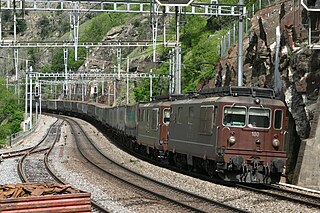
The Bern-Lötschberg-Simplon-Bahn (BLS), known between 1997 and 2006 as the BLS Lötschbergbahn, was a Swiss railway company. In 2006 the company merged with Regionalverkehr Mittelland AG to form a new company called BLS AG.

The Swiss rail network is noteworthy for its density, its coordination between services, its integration with other modes of transport, timeliness and a thriving domestic and trans-Alp freight system. This is made necessary by strong regulations on truck transport, and is enabled by properly coordinated intermodal logistics.

The S-Bahn is a hybrid urban-suburban rail system serving a metropolitan region predominantly in German-speaking countries. Some of the larger S-Bahn systems provide service similar to rapid transit systems, while smaller ones often resemble commuter or even regional rail systems. The name S-Bahn derives from Schnellbahn, Stadtbahn or Stadtschnellbahn.
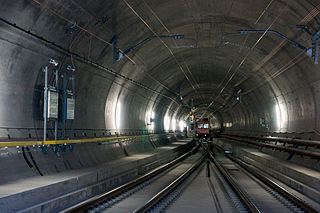
The Gotthard Base Tunnel is a railway tunnel through the Alps in Switzerland. It opened in June 2016 and full service began the following December. With a route length of 57.09 km (35.5 mi), it is the world's longest railway and deepest traffic tunnel and the first flat, low-level route through the Alps. It lies at the heart of the Gotthard axis and constitutes the third tunnel connecting the cantons of Uri and Ticino, after the Gotthard Tunnel and the Gotthard Road Tunnel.

The Gotthard Road Tunnel in Switzerland runs from Göschenen in the canton of Uri at its northern portal, to Airolo in Ticino to the south, and is 16.9 kilometres (10.5 mi) in length below the St Gotthard Pass, a major pass of the Alps. At time of construction, in 1980, it was the longest road tunnel in the world; it is currently the fifth-longest. Although it is a motorway tunnel, part of the A2 from Basel to Chiasso, it consists of only one bidirectional tube with two lanes. With a maximum elevation of 1,175 metres (3,855 ft) at the tunnel's highest point, the A2 motorway has the lowest maximum elevation of any direct north-south road through the Alps.

Maglev is a system of rail transport whose rolling stock is levitated by electromagnets rather than rolled on wheels, eliminating rolling resistance.
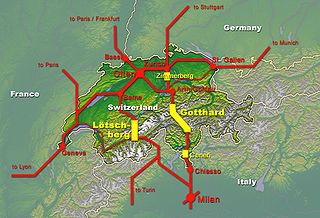
The New Railway Link through the Alps, is a Swiss construction project for faster north–south rail links across the Swiss Alps. It consists of two axes with several improvements along these rails including three new base tunnels several hundred metres below the existing apex tunnels, the 57-kilometre (35 mi) Gotthard Base Tunnel, the 35-kilometre (22 mi) Lötschberg Base Tunnel, and the 15-kilometre (9.3 mi) Ceneri Base Tunnel. Swiss Federal Railways subsidiary AlpTransit Gotthard AG and BLS AG subsidiary BLS Alp Transit AG were founded for this project and built the tunnels.
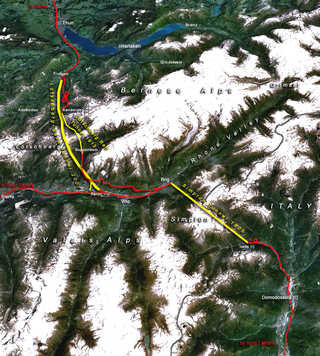
The Lötschberg Base Tunnel (LBT) is a 34.57 km (21.48 mi) railway base tunnel on the BLS AG's Lötschberg line cutting through the Bernese Alps of Switzerland some 400 m (1,300 ft) below the existing Lötschberg Tunnel. It runs between Frutigen, Bern, and Raron, Valais.
A vactrain is a proposed design for very-high-speed rail transportation. It is a maglev line using partly evacuated tubes or tunnels. Reduced air resistance could permit vactrains to travel at very high (hypersonic) speeds with relatively little power—up to 6,400–8,000 km/h (4,000–5,000 mph). This is 5–6 times the speed of sound in Earth's atmosphere at sea level.
The 2000-watt society concept, introduced in 1998 by the Swiss Federal Institute of Technology in Zurich, aims to reduce the average primary energy use of First World citizens to no more than 2,000 watts by 2050, without compromising their standard of living.

The Zimmerberg Base Tunnel (ZBT) is a railway tunnel under the Zimmerberg mountains in Switzerland. Phase I of the tunnel was opened to traffic during April 2003.

Lucerne railway station is a major hub of the rail network of Switzerland, in the city of Lucerne in the canton of Lucerne. It is a terminal station serving domestic and international traffic on several rail lines, and is situated in a city centre and waterfront location on the south side of Lake Lucerne.

Rail 2000 is a large-scale project of the Swiss Federal Railways (SBB CFF FFS) established in 1987 to improve the quality of the Swiss rail network for the New millennium. It includes measures to accelerate a number of existing connections and the modernisation of rolling stock. The federal government decision to support the project in 1986 was approved by a referendum in 1987. In 2004 the first phase was completed consisting of around 130 projects with a budget of around CHF 5.9 billion.

Lugano railway station is the main railway station of the city of Lugano, in the Swiss canton of Ticino. The station is on the Gotthard railway and is also the terminus of the Lugano Città–Stazione funicular. The metre gauge Lugano–Ponte Tresa Railway (FLP) has a separate station at Lugano FLP railway station across the station forecourt from the main line station.

High-speed rail in Switzerland consists of two new lines and three new base tunnels, including the world's longest railway and deepest traffic tunnel: the Gotthard Base Tunnel whose length is 57 km (35 mi). Each of these tunnels have a technical maximum speed of 250 km/h (155 mph), which is reduced, at least in the Gotthard Base Tunnel and the Ceneri Base Tunnel, to a maximum authorized speed of 230 km/h (145 mph), for environmental and economic reasons.
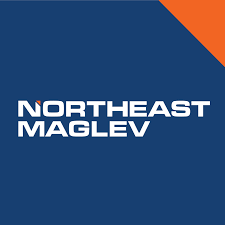
Northeast Maglev is a private U.S. company proposing a maglev train system in the Northeastern United States. The company aims to use the SCMaglev superconducting maglev system developed by the Central Japan Railway Company to provide 15-minute service between Baltimore and Washington, D.C., with an intermediate stop at BWI Airport, and ultimately connect major Northeast metropolitan hubs and airports with a goal of one-hour service from Washington, D.C., to New York City.

Sergio Salvioni (1927-2017) was a Swiss politician and a member of the Swiss Council of States from the Canton of Ticino. He was the son of Arturo and Erminia Salvioni and grandnephew of Prof. Carlo Salvioni, professor of philology and dialectology at the University of Pavia.














